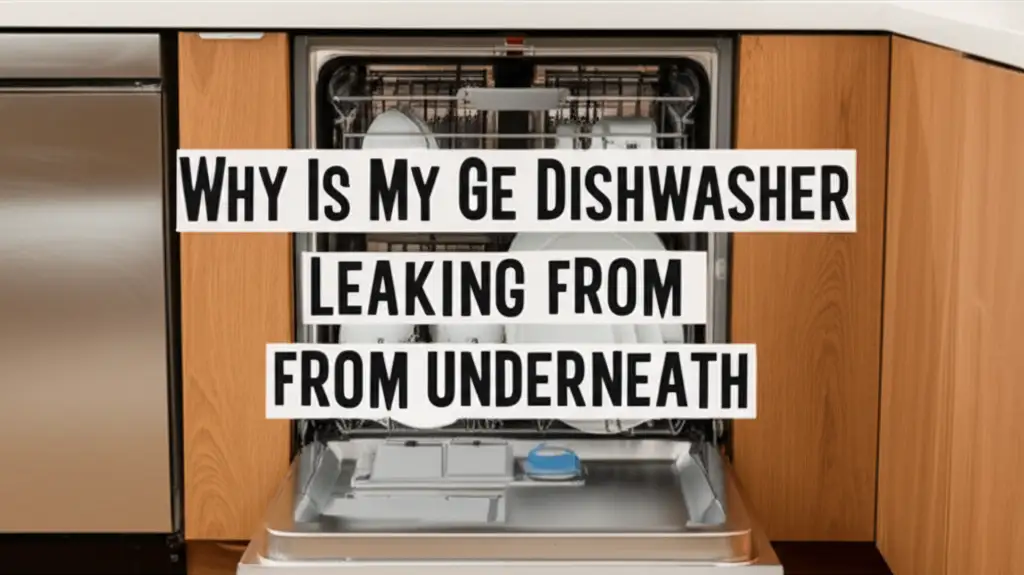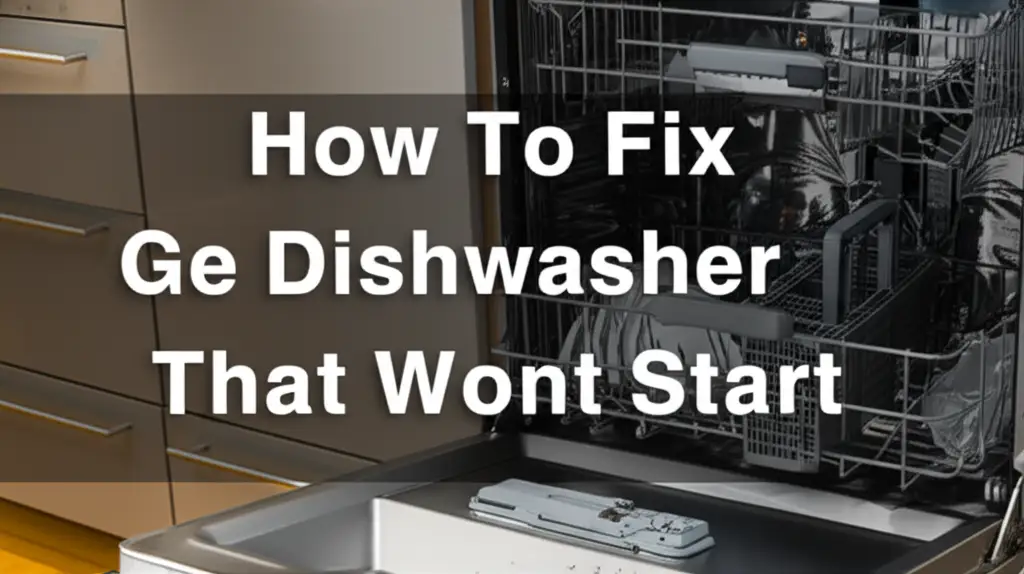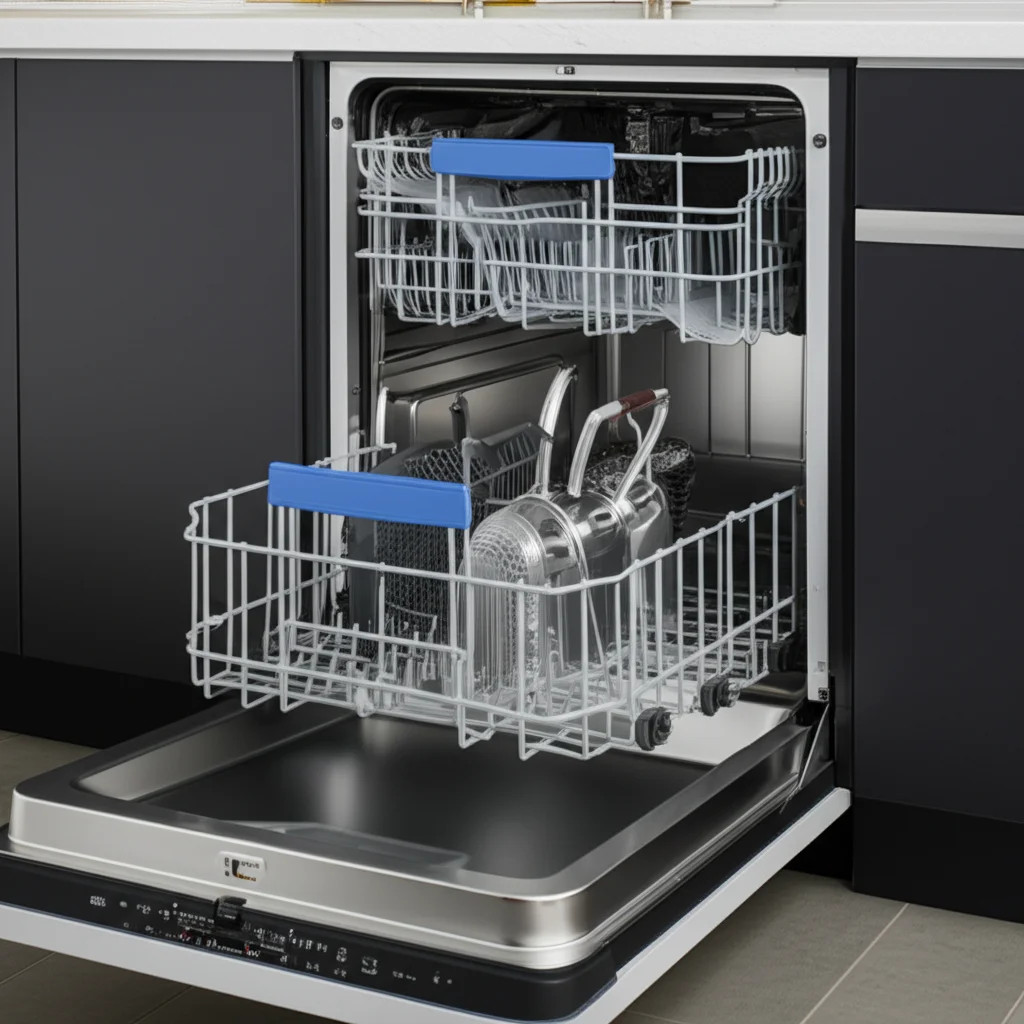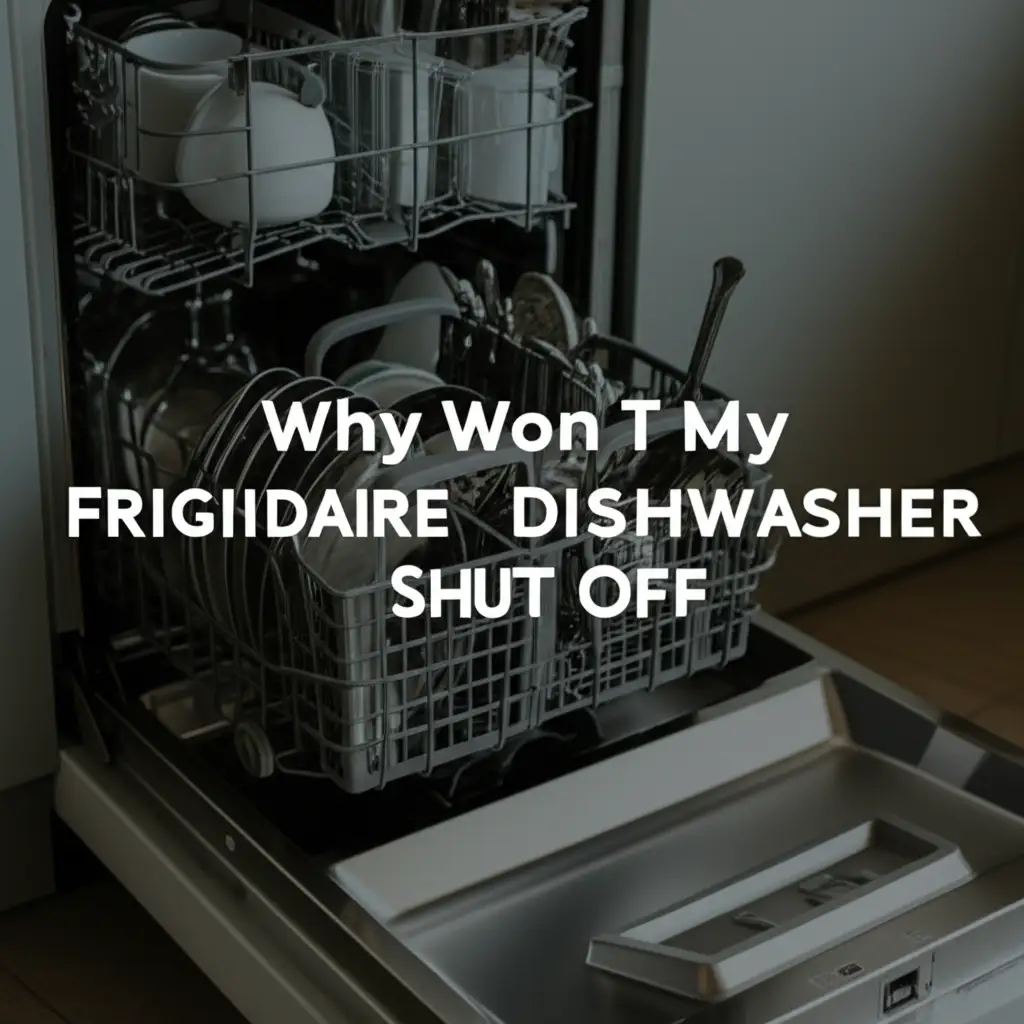· Katria Melrose · Appliance Repair · 13 min read
Why Is My Ge Dishwasher Leaking From Underneath

Why Your GE Dishwasher Leaks From Underneath
A puddle under your GE dishwasher is never a welcome sight. It signals a problem you need to address quickly. When your GE dishwasher is leaking from underneath, it can damage your kitchen floor and cabinets. This issue can stem from various sources, ranging from simple loose connections to more complex component failures. I understand how frustrating it feels to find water where it does not belong.
Many homeowners face this specific problem. Finding the leak’s exact origin helps you fix it properly. This guide will help you understand why your GE dishwasher leaks from underneath. We will explore the common causes and offer clear solutions. You will learn how to diagnose the issue and what steps to take for a lasting repair.
Takeaway
When your GE dishwasher leaks from underneath, take these steps:
- Turn off power and water supply immediately to prevent further damage or electrical hazards.
- Check simple connections first, like the water inlet hose and drain hose, for looseness or damage.
- Inspect the dishwasher’s internal components, such as the water inlet valve, pump, motor, and sump, for visible signs of leaks.
- Address drainage issues, including clogged filters or drain hoses, which can cause water to overflow from the bottom.
- Consider professional help for complex repairs involving seals, motors, or tub cracks, especially if you lack experience.
A GE dishwasher leaking from underneath often results from a faulty water inlet valve, a damaged pump or motor seal, a compromised sump assembly, or loose hose connections. Clogged drainage components can also force water to leak from the appliance’s base. You must pinpoint the exact part causing the leak for a successful repair.
Understanding Your GE Dishwasher’s Underneath Leak: Core Reasons
Discovering water underneath your GE dishwasher can cause immediate concern. This common issue often points to specific internal failures or loose external connections. The water might appear suddenly or slowly over time, making diagnosis important. Understanding the main causes helps you fix the problem efficiently.
Many parts work together to wash your dishes. A failure in any one of these can lead to a leak. We often see leaks related to the water supply, the drainage system, or the circulation pump. Each component has a specific role, and when it fails, water finds a way out. Your dishwasher’s design sends water through various channels, and a breach in any of these pathways results in a leak. I find it helpful to think of the dishwasher as a sealed system, where any break in the seal leads to water escaping.
For example, a hose might become loose over time due to vibrations. A seal can wear out from constant use and high water pressure. Internal components, like the pump or the sump, contain water during the wash cycle. If they crack or their seals fail, water escapes and appears underneath the appliance. Addressing these core reasons systematically saves you time and effort.
Checking GE Dishwasher Water Hoses and Connections for Leaks
One of the simplest reasons your GE dishwasher leaks from underneath involves its hoses and connections. These include the water supply hose, the drain hose, and internal connections within the unit. Loose fittings or damaged hoses are often the first things I check when I see a leak. They are easy to access and relatively simple to repair.
Start by pulling your dishwasher out carefully from its cabinet space. You may need to disconnect the power first for safety. Look at the water inlet hose, which brings fresh water into the dishwasher. This hose connects to a valve on the dishwasher and typically to your home’s water supply line. Check both ends for any signs of water drips or moisture. Sometimes, the connection simply needs tightening. If the hose itself looks cracked or worn, it needs replacement. You can find more details on general dishwasher repair here: How to Repair a Leaking Dishwasher.
Next, examine the drain hose. This hose carries dirty water away from the dishwasher to your sink drain or garbage disposal. Make sure its connections are secure at both ends. Vibrations from the dishwasher can sometimes loosen these connections. Look for any kinks, tears, or holes in the drain hose itself. A damaged drain hose will certainly cause water to leak underneath your appliance. It is important to inspect the entire length of the hose for any compromise.
Investigating the GE Dishwasher’s Water Inlet Valve
The water inlet valve is a crucial component located at the bottom of your GE dishwasher. This valve controls the flow of water into the dishwasher from your home’s supply line. It opens to allow water in at the beginning of a cycle and closes when enough water has entered. If this valve becomes faulty, it can cause a leak directly underneath the appliance.
A common issue with the water inlet valve is that its internal seals can wear out over time. When these seals degrade, water can seep past them even when the valve is supposed to be closed. You might see a steady drip or a slow trickle of water coming from the valve itself. This water will collect on the floor beneath your dishwasher. In some cases, the valve might fail to close completely, leading to overfilling and water spilling from the bottom.
To check the water inlet valve, you will need to pull your dishwasher out from its space. Locate the valve, which is usually a small component with a water line attached to it. Look for visible signs of moisture around the valve body or its connections. If you find water coming directly from the valve, you likely need to replace it. This is a common cause for a GE dishwasher leaking from underneath. This specific issue is similar to problems discussed for GE dishwashers leaking from the bottom: Why Is My GE Dishwasher Leaking From the Bottom.
Addressing Leaks from the GE Dishwasher Pump and Motor Seals
The pump and motor assembly are central to your GE dishwasher’s operation. They circulate water during the wash cycle and then drain it away. This entire assembly sits at the bottom of the dishwasher, making it a prime suspect for leaks appearing underneath. The seals around the pump and motor are designed to keep water contained. Over years of use, these seals can wear out or become brittle.
When the main pump seal fails, water can escape from the pump housing during operation. You might notice a leak primarily during the wash or rinse cycles when the pump is actively moving water. This water will then drip down onto the floor under the dishwasher. A similar issue occurs if the motor shaft seal deteriorates. This seal prevents water from entering the motor itself. If it fails, water can leak out around the motor shaft.
Replacing these seals often requires disassembling part of the dishwasher’s base. It is a more involved repair compared to tightening a hose. You need to ensure the new seals fit perfectly to prevent future leaks. Sometimes, the entire pump or motor assembly needs replacement if the damage is extensive or internal components fail. If you are comfortable with such repairs, you can attempt it. However, many people opt for professional help with these internal components.
Examining the GE Dishwasher’s Sump Assembly and Heating Element Seal
The sump assembly in your GE dishwasher acts as a collection basin for water at the bottom of the tub. It houses several important components, including the pump, the heating element, and sometimes the filter. Because it holds water throughout the wash cycle, any crack or seal failure in the sump can lead to significant leaks from underneath your appliance. The heating element is sealed where it enters the sump, and this seal can also fail.
If the sump itself cracks, water will continuously leak out during the wash cycle. These cracks can be hairline fractures, making them difficult to spot without close inspection. Water will drip directly from the bottom of the dishwasher tub through the crack. Similarly, the rubber gasket or seal around the heating element can degrade. This allows water to escape where the element passes through the sump wall. You might see water seeping around the heating element terminals at the very bottom of the dishwasher.
Checking the sump and heating element seal often requires tilting the dishwasher or removing access panels. Look for any visible signs of water stains, rust, or calcium buildup around the sump’s base or where the heating element connects. If you suspect a crack in the sump, you might need to run a cycle while observing the underside. Replacing a cracked sump or a faulty heating element seal is a complex task. It often means disconnecting many parts.
Drainage System Issues Leading to GE Dishwasher Leaks Underneath
Problems with your dishwasher’s drainage system can also cause water to appear underneath the unit. While not a direct leak from a component, an improper draining situation can lead to overflow. This overflow then spills out and collects under the dishwasher. Several elements contribute to proper drainage, and a blockage in any of them can be the culprit.
One common issue is a clogged drain filter or drain hose. Food particles and debris accumulate in the filter at the bottom of the dishwasher tub. If the filter becomes severely clogged, water cannot drain effectively. This can cause the water level in the tub to rise too high. When the water level exceeds its normal operating height, it can overflow the sump. The excess water then finds its way to the floor underneath. Similarly, a clogged or kinked drain hose prevents water from exiting the dishwasher. This also leads to water backing up inside the tub and potentially overflowing. Sometimes, simply cleaning the filter or straightening a kinked hose can resolve the leak. For more on filter cleaning, refer to: How to Clean Filter in Old GE Dishwasher.
Another drainage-related issue can involve the air gap or the drain check valve. The air gap, if installed, prevents dirty sink water from flowing back into the dishwasher. If it becomes clogged, water can be forced out of the air gap and onto the countertop, eventually tracking down to the floor underneath. The drain check valve ensures water only flows one way out of the dishwasher. If this valve sticks open or becomes faulty, water can backflow into the dishwasher, leading to an overflow situation. Always check these drainage components when you have a leak from underneath.
Detecting a Cracked GE Dishwasher Tub or Detergent Dispenser
While less common, a crack in the dishwasher tub itself can definitely cause water to leak from underneath. The tub is the main enclosure that holds water during the wash cycle. Cracks can develop due to age, impact, or manufacturing defects. These cracks might be small and hard to see. Water will seep through any crack in the tub’s bottom or lower sides and appear directly beneath the appliance.
Inspecting for a tub crack requires a thorough visual check of the entire interior surface. You might need a flashlight to spot hairline fractures, especially in corners or near the heating element. Sometimes, a dye test can help confirm a suspected crack. You would add a small amount of food coloring to the water and observe where it appears underneath. A cracked tub is a serious problem. It often means the entire dishwasher tub needs replacement, which can be as costly as buying a new unit.
Another potential, though rarer, source for an underneath leak is the detergent dispenser. If the seal around the dispenser housing fails, water can leak from it. This water would typically run down the inside of the door and then drip to the floor. However, if the leak is severe, water could track underneath the unit. Inspect the dispenser area for any moisture around its edges, especially when the dishwasher is running. If you find a crack or a failed seal here, the dispenser assembly may need replacement. This type of leak can sometimes mimic a leak from other components underneath.
FAQ Section
Q1: Why does my GE dishwasher leak only sometimes? A GE dishwasher might leak only sometimes if the issue is intermittent. This often happens with loose connections that shift, or seals that only leak under specific pressure or temperature conditions. A partial clog in the drain system can also cause overflow only when water levels reach a certain point. Observe when the leak occurs to pinpoint the cause.
Q2: Can I fix a GE dishwasher leak myself? Many GE dishwasher leaks are fixable yourself, especially those involving loose hoses, clogged filters, or simple seal replacements. For example, tightening a water inlet hose is straightforward. More complex issues, like pump or motor seal failures or cracked tubs, may require specialized tools or skills. I recommend assessing your comfort level before attempting complex repairs.
Q3: What tools do I need to fix a leaking GE dishwasher? Basic tools for a GE dishwasher leak repair include screwdrivers (Phillips and flathead), pliers, a wrench for hose connections, and a bucket and towels for cleanup. For more involved repairs, you might need a flashlight, a multi-meter for electrical checks, and specific replacement parts. Always have safety gloves and eye protection ready.
Q4: How much does it cost to repair a GE dishwasher leak? The cost to repair a GE dishwasher leak varies greatly depending on the cause. Simple fixes like tightening a hose cost nothing. Replacing a water inlet valve might cost $50-$150 for parts. A new pump or motor assembly can range from $150-$400. Professional labor adds to the cost, typically $100-$200 per hour. Consider the repair cost versus buying a new dishwasher.
Q5: Is a GE dishwasher leak dangerous? A GE dishwasher leak can pose several risks. Water near electrical components can cause a short circuit or an electrical shock hazard. Continuous leaks can damage your flooring, subfloor, and cabinetry, leading to mold growth. Always disconnect power to the dishwasher immediately when you notice a leak to prevent these dangers.
Conclusion
Finding your GE dishwasher leaking from underneath can feel overwhelming. However, most leaks stem from common, identifiable issues. We explored everything from simple loose hoses and faulty water inlet valves to more complex pump seal failures and sump cracks. Each potential cause requires a systematic approach to diagnosis. You now have a clear understanding of where to look and what to inspect.
I encourage you to approach the problem calmly and methodically. Start with the easiest checks, such as examining hoses and connections. Then, move on to more involved components like the water inlet valve, pump, and sump assembly. Addressing drainage system clogs is also a vital step. Remember to always prioritize safety by disconnecting power and water before starting any work. Many GE dishwasher leaks are quite manageable with the right information. If the repair seems too complex, do not hesitate to call a qualified appliance technician. They can diagnose and fix the issue safely and effectively, getting your GE dishwasher back to its dry, efficient operation.





